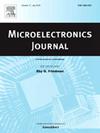基于硅通孔 (TSV) 的三维阻抗匹配网络 (IMN),用于射频能量采集系统
IF 1.9
3区 工程技术
Q3 ENGINEERING, ELECTRICAL & ELECTRONIC
引用次数: 0
摘要
射频能量收集(RFEH)系统可从自然环境中收集射频能量,在户外或人体等特定环境中发挥电池的作用,在传统电池难以更新的场景中展现出巨大的应用潜力。在 RFEH 系统中,阻抗匹配网络(IMN)在标准 CMOS 工艺中会消耗大量金属线材和芯片面积,且不易集成到单片基板中。平面结构具有面积大、寄生影响突出等缺点,限制了其在 REFH 系统中的集成。基于硅通孔(TSV)的三维集成电路技术的发展为射频无源器件提供了一种可能的解决方案。本文设计了一种基于 TSV 的新型 3-D IMN。电容器采用 TSV 结构实现,而电感器则采用再分布层(RDL)螺旋图案设计。三维 LC 匹配电路的协同设计显示了所提解决方案的优点,包括性能高、体积小。它可作为将 IMN 集成到单片 CMOS RFEH 系统中的技术解决方案。本文章由计算机程序翻译,如有差异,请以英文原文为准。
3-D impedance matching network (IMN) based on through-silicon via (TSV) for RF energy harvesting system
Radio Frequency Energy Harvesting (RFEH) system can harvest radio frequency (RF) energy from the natural environment, showing potential applications to play the role of the battery in specific settings, such as outdoors or human body, demonstrating vast potential applications on the scenarios with difficulty to renew the traditional battery. In the RFEH system, Impedance Matching Network (IMN) consumes substantial amounts of metal wire and chip area in standard CMOS process and is not easy to be integrated into the monolithic substrate. The planar structure shows the shortcoming of large area and prominent parasitic influences, limiting its integration in the REFH system. The development of 3-D integrated circuit technology based on Through-Silicon Vias (TSV) offers a possible solution for RF passive devices. In the paper, a novel TSV-based 3-D IMN is designed. The capacitor is implemented with the TSV structure, while the inductor is designed with Redistribution Layer (RDL) spiral pattern. The co-design of 3D LC matching circuit shows the merits of the proposed solution, including high performance and compact size. It can be used as a technical solution for the integration of IMN in a monolithic CMOS RFEH system.
求助全文
通过发布文献求助,成功后即可免费获取论文全文。
去求助
来源期刊

Microelectronics Journal
工程技术-工程:电子与电气
CiteScore
4.00
自引率
27.30%
发文量
222
审稿时长
43 days
期刊介绍:
Published since 1969, the Microelectronics Journal is an international forum for the dissemination of research and applications of microelectronic systems, circuits, and emerging technologies. Papers published in the Microelectronics Journal have undergone peer review to ensure originality, relevance, and timeliness. The journal thus provides a worldwide, regular, and comprehensive update on microelectronic circuits and systems.
The Microelectronics Journal invites papers describing significant research and applications in all of the areas listed below. Comprehensive review/survey papers covering recent developments will also be considered. The Microelectronics Journal covers circuits and systems. This topic includes but is not limited to: Analog, digital, mixed, and RF circuits and related design methodologies; Logic, architectural, and system level synthesis; Testing, design for testability, built-in self-test; Area, power, and thermal analysis and design; Mixed-domain simulation and design; Embedded systems; Non-von Neumann computing and related technologies and circuits; Design and test of high complexity systems integration; SoC, NoC, SIP, and NIP design and test; 3-D integration design and analysis; Emerging device technologies and circuits, such as FinFETs, SETs, spintronics, SFQ, MTJ, etc.
Application aspects such as signal and image processing including circuits for cryptography, sensors, and actuators including sensor networks, reliability and quality issues, and economic models are also welcome.
 求助内容:
求助内容: 应助结果提醒方式:
应助结果提醒方式:


